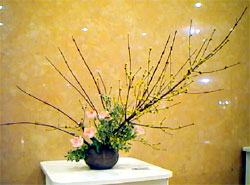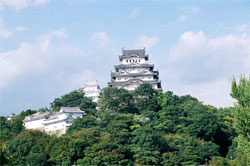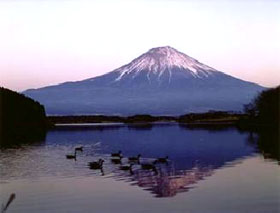|
|
|
|
Top Japan Destinations:
Tokyo hotels Osaka hotels Kyoto hotels Nagoya hotels Sapporo hotels See more hotels in Japan
World Destinations:
 Guides » Japan » Japan: The Magical Land Guides » Japan » Japan: The Magical LandJapan: The Magical Land
If you are planning a trip to Japan, the first thing you need to do is put any of your preconceptions aside. In other words, because Japan is such a diverse country, it is many things to different people.
As an example, if you expect it to be a formal and elegant country, one dripping with custom, then it could be whereas if you expect a candid, modernized country with rural festivals, then it is that as well. Each person visiting this country discovers his or her own vision of what Japan is, never being disappointed. Today, more than 126 million people live in this country with about 12 million living in the capital city of Tokyo.  The first settlers to this magnificent country were simple gatherers and fishers, coming from Korea and Siberia, although some historians also believe Polynesian migrants joined the unique ethnic blend. Then around 300 AD, the Yamato kingdom had been somewhat formed by people who were sun worshippers. Around the mid-6th century, China had introduced Buddhism, which eventually became the state’s religion. However, a problem arose when Shinto when this traditional religion butted heads with Buddhism. However, things calmed down when beliefs changed that Shinto deities were actually manifestations of Buddha. The first settlers to this magnificent country were simple gatherers and fishers, coming from Korea and Siberia, although some historians also believe Polynesian migrants joined the unique ethnic blend. Then around 300 AD, the Yamato kingdom had been somewhat formed by people who were sun worshippers. Around the mid-6th century, China had introduced Buddhism, which eventually became the state’s religion. However, a problem arose when Shinto when this traditional religion butted heads with Buddhism. However, things calmed down when beliefs changed that Shinto deities were actually manifestations of Buddha.
The empire remained stable but when the Ainu arrived during the 9th century, the emperors started to devote more time to scholarly and leisurely interests than to government. Unbeknownst to many, a new power of the Samurai or warrior class was rising, beginning to muscle their way into Japan. The samurai started with the capital called Heian, which is today’s Kyoto. The existing Fujiwara family who dominated many court posts and who were corrupt had a brief clash with the Taira clan, eventually being pushed out by the Minamoto family in 1185. Very quickly, the Minamoto family assumed the military leader or shogun, setting up their headquarters in Kamakura although the emperor remained the ruler in Kyoto. This establishment was the start of many years of a feudal rule by other samurai families, who stayed around until 1868 at which time imperial power was restored. During the feudal centuries, five main periods existed. First, there was the Kamakura Period from 1185 to 1333. Unfortunately, this period was wrought by many Kublai Khan’s Mongol invasions and while they were able to hold them off, the Japanese leadership was weakened. The second period was the Muromachi Period from 1333 to 1576. Under revolt by an angry warrior named Ashikaga, he and his descendants ruled but soon began to lose their effectiveness, causing the country to fall into a civil war. However, during the third period, the Momoyama Period from 1576 to 1600, things in the country were unified. Christianity spread during the Christian Century that began in 1543 and lasted until 1640. While at first the religion was accepted, it was soon stomped on, being seen as a threat. Finally, there was the Tokugawa Period from 1600 to 1867. The leader, Tokugawa Leyasu was able to defeat the younger heir of Hideyoshi, setting up headquarters at Edo, which is today’s Tokyo. Sadly, the Japanese people were not allowed to travel overseas or conduct any type of overseas trading. Their actions with foreigners were guarded and strictly supervised. Sadly, the Tokugawa government was completely corrupt by the beginning of the 19th century. However, as more and more ships came from abroad to try to penetrate the isolation of this country, poverty, and famine began to collapse the government. Then in 1867, Keiki, the ruling shogun stepped down while Emperor Meiji took control again over state matters. With this, the country was taught quickly about industrialization and westernization. Gaining confidence, Japan defeated China during the Sino-Japanese War of 1894 and then again Russia in the Russo-Japanese War of 1904. For World War II, the country took sides with the Allies but never got too involved with conflict, choosing to get more into trade and shipping, which helped push Japan into a strong economy. When Emperor Hirohito took the throne in 1926, nationalism was increased by the Black Depression. With growing unrest however, militant power increased, leading to the attack on Manchuna in 1931, which was the beginning of serious hostility with China. Then in 1940, something pivotal occurred when Japan signed a pact with Italy and Germany. However, when attempts to gain neutrality with the United States were made, the US was taken by surprise with the attack on Pearl Harbor in December of 1941. From there, Japan moved the battle to India, down to Australia, and then even to the mid-Pacific. Soon the counterattack from the United States started the Battle of Midway, which depleted the naval superiority of Japan. By the summer of 1945, Japan had been pushed back on all battlefronts when war was declared by the Soviet Union, dropping atomic bombs on both Nagasaki and Hiroshima. Obviously, this was the end of the war and in 1952, Japan officially surrendered. To try to rebuild the failing economy, a recovery program was established, making Japan the leading and most successful country in the world in the area of export, dominating the robotics, electronics, computing, banking, and car production industries. Even though this massive growth slowed down by 1990, the country was back on its feet when in 1995, a massive earthquake brought down Kobe, soon followed by the poison gas attack in the Tokyo subway by a millennial cult. With current leaders being ousted, a new prime minister was appointed with economic improvement but he died from a horrible stroke just a few years later. Today, the leader is an eccentric man by the name of Junichiro Koizumi, who has brought reform to Japan. Today as you travel through the country, you will be impressed by the strength of the country and all the magnificent culture. The Japanese people are incredible artists, working in various areas of art to include Ikebana, which is a famous type of flower arrangement, paintings, and wood-block prints. Interestingly, many of the museums in Japan are a beautiful blend of old, featuring the early Zen ink paintings to modern day comics known as Manga. You will also find a number of interesting architecture in the form of temples, shrines, and castles. The Shinto shrines are truly magnificent and worth visiting, as are the many Buddhist temples. Even the castles around the country are extremely elaborate. As far as homes, you will find a number of styles ranging from modern style homes and high-rise apartments to gossamer-thin houses that are designed specifically to keep people cool in the hot summers and suffer little damage in case of an earthquake. Music and performances are also very much a part of the Japanese world. For example, you can take in a traditional performance known as Kabuki, which is a melodrama or No, a formal, masked theater performance. The other thing Japan is so famous around the world for is the mystical and magical Japanese gardens. Designed with intricate detail, these gardens are comprised of a number of features to include wood, rock, and water. You can walk through a true Zen garden of rock and gravel, designed to look like water or a vegetation garden filled with the most magnificent plants, trees, and flowers in the world. Typically, there are soothing water features, whether as a fountain, waterfall, or stream, often filled with Koi fish and featuring small bridges on which you can stand. Of course, if you get the chance to visit a garden where traditional tea ceremonies are held, you will see the gentle nature of the Japanese people and the peaceful lifestyle in which some still live. As far as Japanese literature, most of the early writing was done by women. The men, who had education, wrote in Chinese characters while the women, denied this same educational opportunity, wrote in Hiaigana, which is Japanese script. One of the most impressive and important pieces written was done by a woman named Murasaki Shikibu. Her work, “The Tale of Genji” was about the intrigues associated with the early Japanese court life. Following her would be a number of other famous writings, as well as Haiku poetry, which appeared sometime during the 17th century. For non-Japanese, the Japanese writing system is the most complex in the entire world. Using three types of scripts, it takes people years and years to grasp the basic concept. However, when visiting Japan, you will find that most of the restaurants, many of the tourist signs, etc, are written or provided in English, which is widely spoken. The Japanese also love to drink, something that most adults and many teenagers enjoy. Beer is a huge seller, often found supplied in vending machines just as a can of soda. However, rice wine, also known as sake, is served cold or warm and often with meals. Just keep in mind when ordering sake that it goes down extremely smooth but will hit hard. Therefore, sip and do not go overboard. For non-alcoholic beverages, green tea is both refreshing and healthy. Dining out in Japan is a memorable treat. The food is exceptional, starting with fresh sushi, sukiyaki, or tempura. Typically, a Japanese restaurant will focus on one particular specialty but you can find places known as Shokudo, which are all-around eateries where the menu is more diverse. Another fun dining experience is Okonomiyaki, which is a cook-it-yourself type restaurant. With this, you choose meat, seafood, and vegetables, which are fried up in a special vegetable and cabbage batter. Again, Sukiyaki is a favorite traditional food, which is thin sliced beef, vegetables, and tofu all cooked together in a delicious broth. Another favorite is called Shabu-Sahbu, a beef and veggie dish in broth and then dipped in sauce. Food is both delicious and affordable in Japan and for added convenience, you can choose from a number of Bentos, which are boxed lunches or Teishoku, set meals. Regardless of the style of Japanese food you choose, the majority of dishes are simply wonderful. Floating on the rim of the Asian continent, Japan was first formed some 10,000 years ago. Today, Japan is actually a chain of island that consists of four that are the primary islands and then about 1,000 smaller islands. The land is beautiful and green, and the landscape is dotted with spectacular mountains to include the famous Mt. Fuji, which is the tallest. In addition to the fascinating places outdoors, the cities also offer a bright and exciting nightlife and shopping. For an amazing journey into a country like none other, a trip to Japan would be the perfect choice. Last Updated: 10/19/2006 3:14:00 PM Mode articles for Japan Ikebana is a traditional art form of Japan that has been practiced for the past 600 years. The development of Ikebana came as a ritualistic offering from the Buddhist to the spirits of the dead in the form of flowers.
Ikebana is a traditional art form of Japan that has been practiced for the past 600 years. The development of Ikebana came as a ritualistic offering from the Buddhist to the spirits of the dead in the form of flowers. ... continue >>  When visiting the country of Japan, plan adequate time and wear comfortable clothing and shoes so you can enjoy the incredible sightseeing opportunities. In Japan, many of the places people go to see and experience are
When visiting the country of Japan, plan adequate time and wear comfortable clothing and shoes so you can enjoy the incredible sightseeing opportunities. In Japan, many of the places people go to see and experience are ... continue >>  The highest mountain in all of Japan is called Mt. Fuji, reaching skyward to 12,385 feet. This mountain is the only natural feature typically explored by tourists, simply because it is so magnificent. This perfectly
The highest mountain in all of Japan is called Mt. Fuji, reaching skyward to 12,385 feet. This mountain is the only natural feature typically explored by tourists, simply because it is so magnificent. This perfectly ... continue >> |
|
| | |
|
©2025 HotelsRu.com About us Privacy Site map Japan: The Magical Land |
|
 Look for deals on hotels?
Look for deals on hotels?